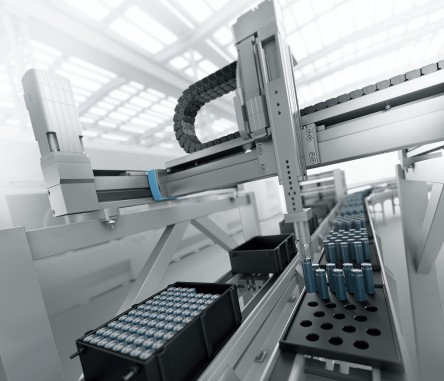
電動汽車和電池的製造設備爲先進的大規模批量製造設備,並無縫整合工廠與過程自動化。這種高度工業自動化程度可確保符合嚴格的安全性要求與性能要求所需的精度、均勻性和穩定性。
隨着創新技術和方法的應用,也直接對技能要求產生影響,從而導致員工的技能不足。這種不足會在短時間內導致生產過程中出現嚴重情況。

提高先進製造業的相應能力。
爲了保證員工在工業4.0的背景下成功完成工作,需要掌握更加廣泛全面的能力,以實現高度靈活性和提高生產力,並加深對系統的全面瞭解。關鍵的數位化故障排除技能和能力不可或缺。全面的軟技能包括批判性思維、溝通、合作和創造力等等,可在跨學科團隊內部實現高效決策和問題解決能力。此外也需要不斷適應千變萬化的環境以及培養終身學習的能力。
因此,學校教師和企業講師必須加大力度,根據行業要求調整或制定培訓計劃。透過與領先電池和電動汽車製造商的獨家合作,我們聽取了他們對企業員工職業訓練和技能提升以及新員工入職的寶貴意見。
生產員工所在的主要領域
具備專業技能的生產員工(例如操作人員和維護技術人員)是勞動力需求的主體。依據不同的職位,這些員工負責安裝、運行、監測、維護、故障排除和生產設備更換。
爲了提高生產力,員工應具備以下領域和主題的知識與技能:
電池生產
電池、模組和組件。部件和原材料。電極製造。電池安裝。成型和老化。物流和材料處理。生產品質和資料管理。過程環境。廢物處理。過程安全性和產品安全性。未來發展趨勢。生產過程中的挑戰。更多
流體動力學系統
執行器。空氣淨化。真空技術。夾爪。軟管和附件。作用力控制。氣動/液壓類比。壓力開關。電磁式閥門。標記和讀取電路圖。物理原理。結構和功能原理。壓力量測和流量量測。閥門和操作元件。比例液壓系統基礎知識。關鍵階段和潛在風險。更多。
感測器和資料
工業控制系統。電氣工程基礎知識。圖表。邏輯基礎功能。直接和間接控制。控制電路。訊號記錄。閂鎖電路。按鈕、開關和探測器。繼電器和感測器。計時器。PLC。智能感測器。機械人技術。更多。
儀器儀表和過程控制
瞭解控制系統。HMI。SCADA。MES。感測器和傳送器。溫度感測器。壓力感測器。液位感測器。流量感測器。截止閥和過程閥。儀表圖。更多。
電氣和機械驅動裝置
馬達(直流、同步、異步)。馬達(伺服、步進馬達)。軸承和聯軸器。皮帶傳動和皮帶輪。鏈條傳動和傳動輪。齒輪。潤滑裝置。更多。
工業維護
量測設備的一般應用。一般和進階故障排除。預防性和預測性維護。資料分析。電氣和機械故障排除。系統隔離。優化裝備。尺度計量學。泵。捆紮。管道鋪設。佈線。更多。
卓越營運
完整的生產性檢修。能源效率。制定故障排除方法。持續優化。工業4.0基礎。精益生產。5S工作管理組織。材料學。防呆 (Poka - Yoke)。更多。
品質、安全性
形狀和位置公差。統計過程控制 (SPC)。電氣標準和法規。個人防護裝備。機械安全性(SIL、PL等等)和聯鎖。安全控制元件和類別。安全模組的功能原理。停止按鈕。保護屏障。上鎖掛牌方法。電能放電。更多。
工程師需求的其他領域
例如電氣、電子、軟件和化學工程師在電動汽車和電池製造領域也具有需求。他們在各個層面上參與工作:研究與開發、設計與規劃以及生產。
除了必須掌握生產員工應具備的能力和知識之外,工程師還必須在以下重要領域發揮其專業技能和能力:
電動傳動系統
傳動系統的控制和特徵。馬達、減速機和傳動軸。電動馬達。感測器和操作裝置。發電。能源消耗。煞車系統。再生煞車。汽車機電一體化。更多。
電力電子技術
直流電力電子技術:二極管、開關電晶體、高速斷路器、殘餘波紋、電池充電器、斬波器等等。單相和三相交流電力電子技術:整流器、二極管整流器、PWM逆變器等等。閘流體電力電子技術:固態繼電器、交流電力控制、整流器/逆變器。更多。
電池技術
基本特性。串聯和並聯。不同電池類型。電池組和電池箱。充電。放電。能量密度。電池管理系統和平衡電池。更多。
充電基礎設施
充電站和充電流程。能量轉換和能量儲存。智能網絡。分配網絡。可再生能源生產。更多。
能源管理
能源效率。消耗監測。能源供應。優化。更多。
網絡連結、網絡安全
網絡和IT安全。設備安全。分析威脅和風險。防止入侵的系統。更多。